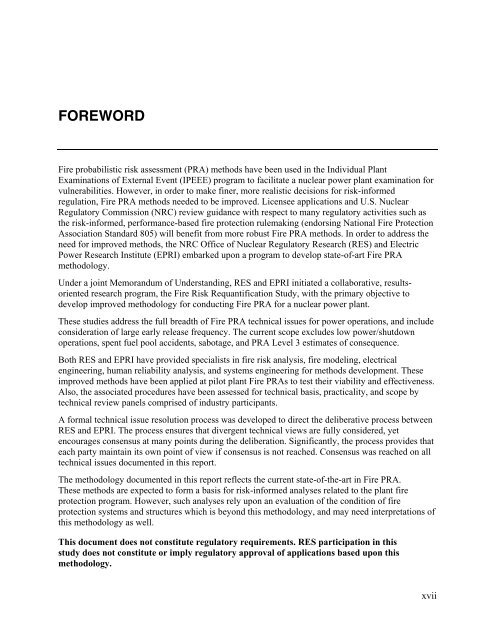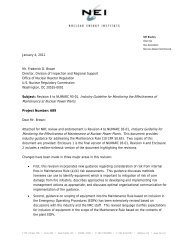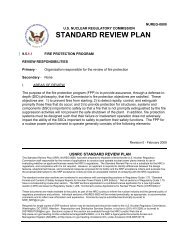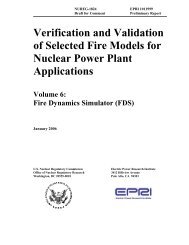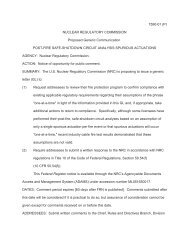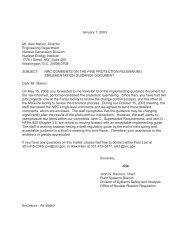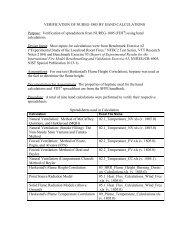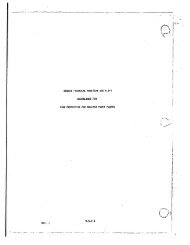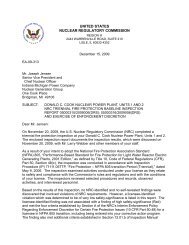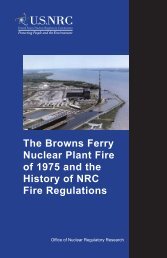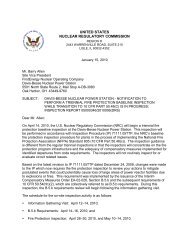NUREG/CR-6850, Volume 1 - NRC
NUREG/CR-6850, Volume 1 - NRC
NUREG/CR-6850, Volume 1 - NRC
Create successful ePaper yourself
Turn your PDF publications into a flip-book with our unique Google optimized e-Paper software.
FOREWORDFire probabilistic risk assessment (PRA) methods have been used in the Individual PlantExaminations of External Event (IPEEE) program to facilitate a nuclear power plant examination forvulnerabilities. However, in order to make finer, more realistic decisions for risk-informedregulation, Fire PRA methods needed to be improved. Licensee applications and U.S. NuclearRegulatory Commission (<strong>NRC</strong>) review guidance with respect to many regulatory activities such asthe risk-informed, performance-based fire protection rulemaking (endorsing National Fire ProtectionAssociation Standard 805) will benefit from more robust Fire PRA methods. In order to address theneed for improved methods, the <strong>NRC</strong> Office of Nuclear Regulatory Research (RES) and ElectricPower Research Institute (EPRI) embarked upon a program to develop state-of-art Fire PRAmethodology.Under a joint Memorandum of Understanding, RES and EPRI initiated a collaborative, resultsorientedresearch program, the Fire Risk Requantification Study, with the primary objective todevelop improved methodology for conducting Fire PRA for a nuclear power plant.These studies address the full breadth of Fire PRA technical issues for power operations, and includeconsideration of large early release frequency. The current scope excludes low power/shutdownoperations, spent fuel pool accidents, sabotage, and PRA Level 3 estimates of consequence.Both RES and EPRI have provided specialists in fire risk analysis, fire modeling, electricalengineering, human reliability analysis, and systems engineering for methods development. Theseimproved methods have been applied at pilot plant Fire PRAs to test their viability and effectiveness.Also, the associated procedures have been assessed for technical basis, practicality, and scope bytechnical review panels comprised of industry participants.A formal technical issue resolution process was developed to direct the deliberative process betweenRES and EPRI. The process ensures that divergent technical views are fully considered, yetencourages consensus at many points during the deliberation. Significantly, the process provides thateach party maintain its own point of view if consensus is not reached. Consensus was reached on alltechnical issues documented in this report.The methodology documented in this report reflects the current state-of-the-art in Fire PRA.These methods are expected to form a basis for risk-informed analyses related to the plant fireprotection program. However, such analyses rely upon an evaluation of the condition of fireprotection systems and structures which is beyond this methodology, and may need interpretations ofthis methodology as well.This document does not constitute regulatory requirements. RES participation in thisstudy does not constitute or imply regulatory approval of applications based upon thismethodology.xvii


